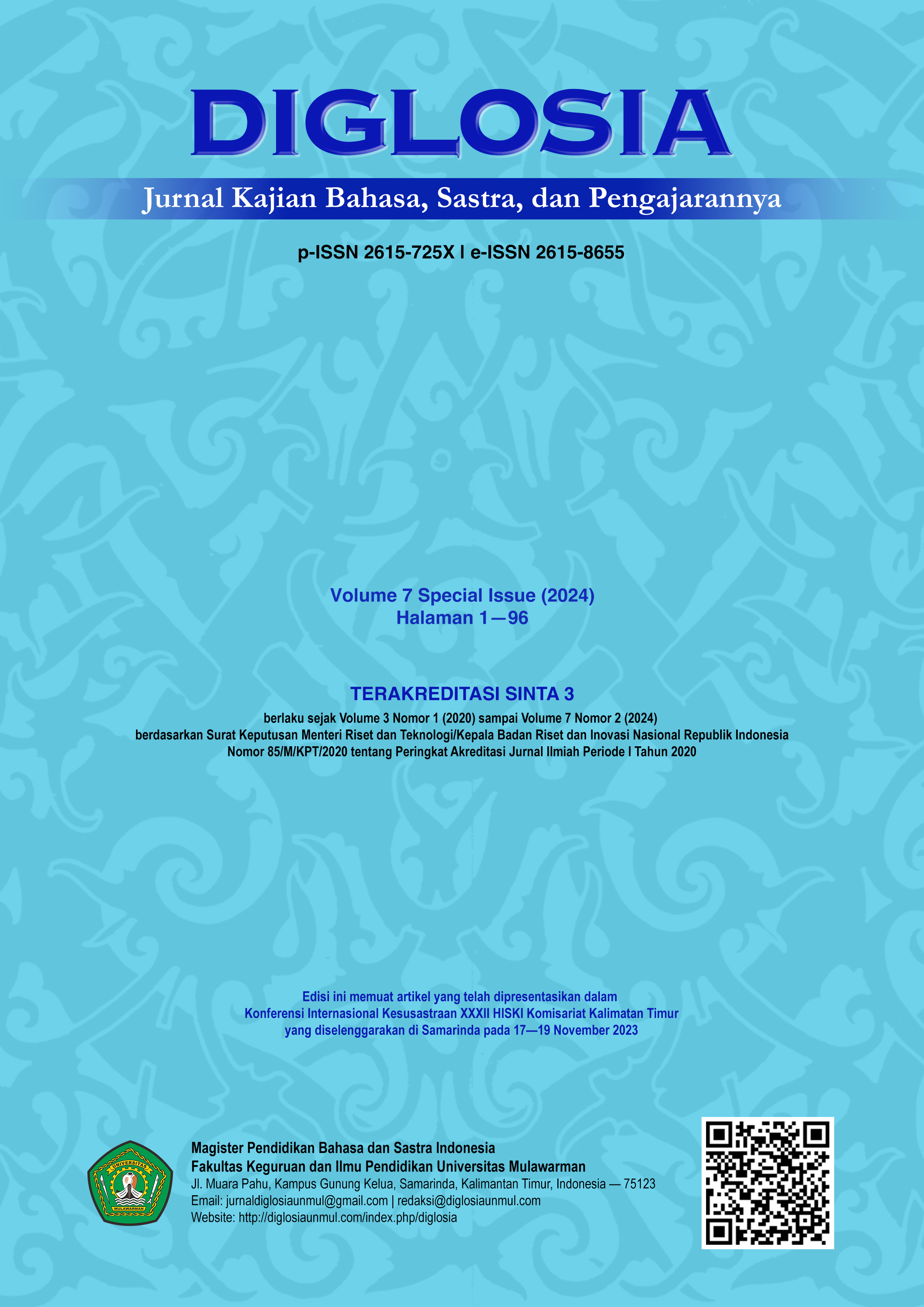Orientalism discourse reversal in Budi Darma’s Tarom short story Pembalikan wacana orientalisme dalam cerpen “Tarom” karya Budi Darma
Main Article Content
Abstract
This paper aims to examine the short story Tarom by Budi Darma with theoretical knife of orientalism. The method in this study uses descriptive qualitative. The data collection technique uses the close-reading method, while the analysis technique uses the dialectical method. Edward Said’s Orientalism as a formal object and Budi Darma’s short story Tarom published by Kompas newspaper is a material object. The results of study suggest that, first, there is a polarization of ‘West’ and ‘East’ which is represented by the characters in the short story. The West in this case is depicted Germany and the East shown is Japan. Second, it does not only describe the polarization of the West and the East, but also shows the discourse of resistance. Through the depiction of the Tarom character, this short story shows the existence of a Western body with Easten thoughts. Thus, the short story Tarom displays a narrative of reversal of the Orientalism discourse.
Downloads
Article Details
![]()
Every work in Diglosia: Jurnal Kajian Bahasa, Sastra, dan Pengajarannya is licensed under a Creative Commons Attribution-ShareAlike 4.0 International License.
Under the following terms:
- Attribution — You must give appropriate credit , provide a link to the license, and indicate if changes were made . You may do so in any reasonable manner, but not in any way that suggests the licensor endorses you or your use.
- ShareAlike — If you remix, transform, or build upon the material, you must distribute your contributions under the same license as the original.
- No additional restrictions — You may not apply legal terms or technological measures that legally restrict others from doing anything the license permits.
Authors who publish with this journal agree to the following terms:
- Authors retain copyright and grant the journal right of first publication with the work simultaneously licensed under a CC BY-SA 4.0 DEED Attribution-ShareAlike 4.0 Internationalthat allows others to share the work with an acknowledgment of the work's authorship and initial publication in this journal.
- Authors are able to enter into separate, additional contractual arrangements for the non-exclusive distribution of the journal's published version of the work (e.g., post it to an institutional repository or publish it in a book), with an acknowledgment of its initial publication in this journal.
- Authors are permitted and encouraged to post their work online (e.g., in institutional repositories or on their website) prior to and during the submission process, as it can lead to productive exchanges, as well as earlier and greater citation of published work.
References
Barry, P. (2002). Beginning Theory: An Introduction to Literary and Cultural Theory: Vol. II. Oxford University Press.
Burke, E., & Prochaska, D. (2007). Rethinking the Historical Genealogy of Orientalism. History and Anthropology, 18(2), 135–151. https://doi.org/10.1080/02757200701218262
Darma, B. (2017, January 3). Tarom. Kompas Newspaper. https://catatanpringadi.com/tarom-cerpen-budi-darma/
Djohar, H. I. (2019). Folktales and Rites of Passage in Randa Jarrar’s a Map of Home. Poetika, 7(2), 148–157. https://doi.org/10.22146/poetika.v7i2.51160
Faruk. (2012). Metode Penelitian Sastra: Sebuah Penjelajahan Awal. Pustaka Pelajar.
Lestari, W. D., Suwandi, S., & Rohmadi, M. (2019). Kaum Subaltern dalam Novel-Novel Karya Soeratman Sastradihardja: Sebuah Kajian Sastra Poskolonial. Widyaparwa, 46(2), 178–188. https://doi.org/10.26499/wdprw.v46i2.175
Makin, A. (2015). Antara Barat dan Timur: Batasan, Dominasi, Relasi dan Globalisasi. Serambi.
Moore-Gilbert, B. (1997). Postcolonial Theory: Contexts, Practices, Politics. Verso.
Nur Sakinah, R. M. (2014). Pandangan Orientalis terhadap Identitas dan Isu Politik Tokoh Perempuan dalam Putri Cina. Patanjala: Jurnal Penelitian Sejarah Dan Budaya, 6(2), 209–222. https://doi.org/10.30959/ptj.v6i2.195
Rosyid HW, M. (2021). Peran Sosial Kiai pada Masa Kolonial Karya-Karya Djamil Suherman dalam Telaah Sosiologi Sastra. Aksara, 33(1), 25–38. https://doi.org/10.29255/aksara.v33i1.547.25-38
Said, E. (1979). Orientalism. Vintage Books.
Sehandi, Y., & Bala, A. (2021). Membaca Jejak Proses Kreatif Penyair Nusa Tenggara Timur, John Dami Mukese. Diglosia: Jurnal Kajian Bahasa, Sastra, Dan Pengajarannya, 4(1), 23–36. https://doi.org/10.30872/diglosia.v4i1.88
Sulatri, N. L. P. A., & Damayanti, S. (2022). Pulau dan Identitas yang Ditinggalkan dalam Shimagomoru Karya Tami Sakiyama: Kritik Sastra Ekofeminisme. Diglosia: Jurnal Kajian Bahasa, Sastra, Dan Pengajarannya, 5(4), 835–844. https://doi.org/10.30872/diglosia.v5i4.509
Tawaqal, W., Mursalim, & Hanum, I. S. (2020). Pilihan Hidup Tokoh Utama Zarah Amala dalam Novel “Supernova Episode: Partikel” Karya Dee Lestari: Kajian Feminisme Liberal. Diglosia: Jurnal Kajian Bahasa, Sastra, Dan Pengajarannya, 3(4), 435–444. https://doi.org/10.30872/diglosia.v3i4.165
Thomson, A. (2010). What Is Literature? In D. Cavanagh, A. Gillis, M. Keown, J. Loxley, & R. Stevenson (Eds.), The Edinburgh Introduction to Studying English Literature, 2nd edition (pp. 3–15). Edinburgh University Press.
Udasmoro, W., & Setiadi, S. (2021). Gender Discourses in Positioning Indonesian Female Migrant Workers. Jurnal Ilmu Sosial Dan Ilmu Politik, 24(3), 237–252. https://doi.org/10.22146/jsp.54034
Widyantara, P. D., Aryani, I. G. A. I., & Malini, N. L. N. S. (2021). The Plot of the Characters in All the Bright Places. Aksara, 32(2), 259–274. http://dx.doi.org/10.29255/aksara.v32i2.564.259-274
Young, R. J. C. (2023). Postcolonialism: A Very Short Introduction. Oxford University Press.
Zamzuri, A. (2021). Kuliner, Tubuh, dan Identitas: Sebuah Pembacaan Gastro-Semiotika terhadap Sepilihan Puisi Karya Hanna Fransisca. Aksara, 33(1), 1–10. https://doi.org/10.29255/aksara.v33i1.721.1-10

